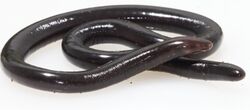Biology:Gymnophiona
| Gymnophiona | |
|---|---|

| |
| Caecilia pulchraserrana | |
| Scientific classification | |
| Domain: | Eukaryota |
| Kingdom: | Animalia |
| Phylum: | Chordata |
| Class: | Amphibia |
| Subclass: | Lissamphibia |
| Order: | Gymnophiona Müller, 1832[2] |
| Subgroups | |
| Synonyms[2] | |
| |
Gymnophiona /dʒɪmnəˈfaɪənə/ is the group of amphibians that includes the legless caecilians and all amphibians more closely related to them than to frogs or salamanders (the "stem-caecilians").[3] The name derives from the Greek words γυμνος (gymnos, naked) and οφις (ophis, snake), as the caecilians were originally thought to be related to snakes. The body is cylindrical dark brown or bluish black in colour. The skin is slimy and bears grooves or ringlike markings.
Evolution
Little is known of the evolutionary history of the caecilian lineage, which has left a sparse fossil record.[4] The first fossil belonging to this group, a vertebra dated to the Paleocene, was not discovered until 1972.[5] The first pre-Cenozoic genus, Eocaecilia, had small limbs and well-developed eyes.[6]
In their 2008 description of the fossil batrachian Gerobatrachus,[7] Anderson and co-authors suggested that caecilians arose from the Lepospondyl group of ancestral tetrapods, and may be more closely related to amniotes than to frogs and salamanders, which arose from Temnospondyl ancestors. Numerous groups of lepospondyls evolved reduced limbs, elongated bodies, and burrowing behaviors, and morphological studies on Permian and Carboniferous lepospondyls have placed the early caecilian (Eocaecilia) among these groups.[8] Divergent origins of caecilians and other extant amphibians may help explain the slight discrepancy between fossil dates for the origins of modern amphibia, which suggest Permian origins, and the earlier dates, in the Carboniferous, predicted by some molecular clock studies of DNA sequences. Most morphological and molecular studies of extant amphibians, however, support monophyly for caecilians, frogs, and salamanders, and the most recent molecular study based on multi-locus data suggest a Late Carboniferous–Early Permian origin of extant amphibians.[9] The Late Triassic stem-caecilian Chinlestegophis from the Chinle Formation of Colorado bolsters the proposed pre-Triassic origin of Lissamphibia suggested by molecular clocks by filling a gap in the fossil record of early caecilians and suggesting that groups of stereospondyls, including Metoposauridae, are closely related to caecilians.[10] However, affinities between Chinlestegophis and gymnophionans have been disputed both because of the choice of characters[4] and because reanalysis of the original data matrix supports other equally parsimonious positions of Chinlestegophis and gymnophionans among tetrapods.[11]
Relationships
The most recent phylogeny of caecilians is based on molecular mitogenomic evidence examined by San Mauro et al. (2014).[12]
| Gymnophiona |
| ||||||||||||||||||||||||||||||||||||||||||||||||||||||||||||||||||
References
- ↑ Nussbaum, Ronald A. (1998). Cogger, H.G.. ed. Encyclopedia of Reptiles and Amphibians. San Diego: Academic Press. pp. 52–59. ISBN 0-12-178560-2.
- ↑ 2.0 2.1 Frost, Darrel R. (2019). "Gymnophiona Müller, 1832". Amphibian Species of the World: an Online Reference. Version 6.0. American Museum of Natural History. http://research.amnh.org/vz/herpetology/amphibia/Amphibia/Gymnophiona.
- ↑ Evans, Susan E.; Sigogneau-Russell, Denise (2001). "A stem-group caecilian (Lissamphibia: Gymnophiona) from the Lower Cretaceous of North Africa". Palaeontology 44 (2): 259–273. doi:10.1111/1475-4983.00179.
- ↑ 4.0 4.1 Santos, Rodolfo Otávio; Laurin, Michel; Zaher, Hussam (2020). "A review of the fossil record of caecilians (Lissamphibia; Gymnophionomorpha) with comments on its use to calibrate molecular timetrees". Biological Journal of the Linnean Society 131 (4): 737–755. doi:10.1093/biolinnean/blaa148.
- ↑ Estes, Richard; Wake, Marvalee H. (22 September 1972). "The first fossil record of caecilian amphibians". Nature 239 (5369): 228–231. doi:10.1038/239228b0. Bibcode: 1972Natur.239..228E.
- ↑ Jenkins, Parish A.; Walsh, Denis M. (16 September 1993). "An Early Jurassic caecilian with limbs". Nature 365 (6443): 246–250. doi:10.1038/365246a0. Bibcode: 1993Natur.365..246J.
- ↑ Anderson, Jason S.; Reisz, Robert R.; Scott, Diane; Fröbisch, Nadia B.; Sumida, Stuart S. (2008). "A stem batrachian from the Early Permian of Texas and the origin of frogs and salamanders". Nature 453 (7194): 515–518. doi:10.1038/nature06865. PMID 18497824. Bibcode: 2008Natur.453..515A.
- ↑ Huttenlocker, A. K.; Pardo, J. D.; Small, B. J.; Anderson, J. S. (2013). "Cranial morphology of recumbirostrans (Lepospondyli) from the Permian of Kansas and Nebraska, and early morphological evolution inferred by micro-computed tomography". Journal of Vertebrate Paleontology 33 (3): 540–552. doi:10.1080/02724634.2013.728998..
- ↑ San Mauro, D. (2010). "A multilocus timescale for the origin of extant amphibians". Molecular Phylogenetics and Evolution 56 (2): 554–561. doi:10.1016/j.ympev.2010.04.019. PMID 20399871.
- ↑ Pardo, Jason D.; Small, Bryan J.; Huttenlocker, Adam K. (2017). "Stem caecilian from the Triassic of Colorado sheds light on the origins of Lissamphibia". Proceedings of the National Academy of Sciences of the United States of America 114 (27): E5389–E5395. doi:10.1073/pnas.1706752114. PMID 28630337.
- ↑ Marjanović, David; Laurin, Michel (2019). "Phylogeny of Paleozoic limbed vertebrates reassessed through revision and expansion of the largest published relevant data matrix". PeerJ 6 (e5565): e5565. doi:10.7717/peerj.5565. PMID 30631641.
- ↑ San Mauro, D.; Gower, D. J.; Müller, H.; Loader, S. P.; Zardoya, R.; Nussbaum, R. A.; Wilkinson, M. (2014). "Life-history evolution and mitogenomic phylogeny of caecilian amphibians". Molecular Phylogenetics and Evolution 73: 177–189. doi:10.1016/j.ympev.2014.01.009. PMID 24480323..
External links
Wikidata ☰ Q4758 entry

